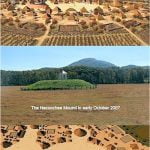
Around 900 AD a massive, five-side mound was constructed near the modern-day village of Sautee. It was at the foot of Yonah Mountain and aligned directly with the longitude of the new town of Ocmulgee, about 145 miles to the south. This mound was not occupied very long.
Around 1050 AD astronomer-priests arrived in the Nacoochee Valley from the new town of Etalwa (Etowah Mounds.) They designated a location in the valley where the natural mountain peaks to mark the solstices and equinoxes of the sun. A small mound was constructed at this spot and a hamlet grew up around it. The priests, called Keepers, also introduced the large scale cultivation of corn, beans, squash and pumpkins. Poles placed atop the small mound were used to tell the farmers when to plant their seeds and harvest their crops.
The new mound grew slowly in size. Each time the Chief Priest-leader of the religious shrine died, the temple was razed and the mound expanded. With the rise of the Kusa (pronounced Kau-sha in the Hitchiti-Creek language of its people) both the mound and the village increased dramatically in size. The Kusa capital was to the west on the Coosawattee River, The additions to the mound made it oval shaped and oriented to the west – the setting sun on the Equinox. This was the Kusa tradition.
News of the appearance of strange light-skinned men with powerful weapons probably reached the Nacoochee Valley, shortly after the Spanish attempted to found their first colony on the South Atlantic Coast, somewhere between Charleston, SC and St. Marys, GA. The first actual visit to the town of Nokose by the Spaniards was probably in the autumn of 1667. Captain Juan Pardo probably passed through there on his way back to the Spanish colony of Santa Elena on Paris Island, SC. Already though, strange diseases were beginning to reduce the population of the valley. It was at the intersection of several north-south/east-west trails. Both merchants and refugees fleeing plagues would have transmitted the invisible pathogens, when they stayed at guest houses in the village. The world of Nacoochee Valleys people was about to change traumatically.
The Native American Holocaust
Around the year 1500 AD, a small pox plague was spread by Maya merchant boats to the Yucatan Peninsula and then to Cuba and the Gulf Coast of Florida. By the time the first Spanish explorers reached Florida and the Gulf Coast of what is now the United States, many towns had already been decimated. Somewhere between 1/4th to 1/3 of the people of central Mexico died of European diseases such as smallpox in a horrific period that began with the arrival of Hernando Cortezs conquistadors. Mexico continued to have massive plagues among its native peoples throughout the 1500s. The indigenous population declined about 95% during the period. The Valley of Mexico, where Mexico City is located, did not reach its pre-European population again until the 20th century.
Inland locales, such as the Nacoochee Valley, did not seem to be affected significantly by the early Spanish introduced pathogens in Mexico and the coasts until 1585. The population of the valley declined somewhat as strange diseases spread outward from the path of de Sotos expedition, but the communities still existed. Something very different happened in 1585. A hemorrhagic fever appeared in the cooler, more temperate regions of Mexicos highlands. With gross symptoms similar to that Ebola Fever in Africa, it often killed its victims within a day. Villages changed into scenes of bodies lying in pools of blood and putrefied flesh. The death rate in some of the coolest, wettest areas approached 100%. Strangely, the plague did not appear in tropical areas of Mexico, where one would expect diseases to be most virulent.
Some time around 1585 or a little later, virtually all of the great Native towns of northern Alabama, southeastern Tennessee, northwestern Georgia and western North Carolina were suddenly abandoned. All mound-building permanently stopped. Most of the large towns in northern Georgia and Alabama were never reoccupied. All of the large towns on the middle Chattahoochee River were permanently abandoned. Strangely, just like in the case in Mexico, towns with warmer climates continued to be occupied . . . some until the early 1800s. The hemorrhagic plague of the Mexican Highlands appears to be a likely culprit. Some migratory bird or perhaps even the Monarch butterfly possibly carried the pathogen from Mexico to the Southern Highlands.
No more construction was done on the Nacoochee Mound after the late 1500s. Apparently, some Native people still lived there, but their population was too diminished to carry out major public works. There is some evidence and old traditions that a few survivors of the Roanoke Colony made it to the Nacoochee Valley, where they intermarried with the local ancestors of the Creeks and lived their last days.
